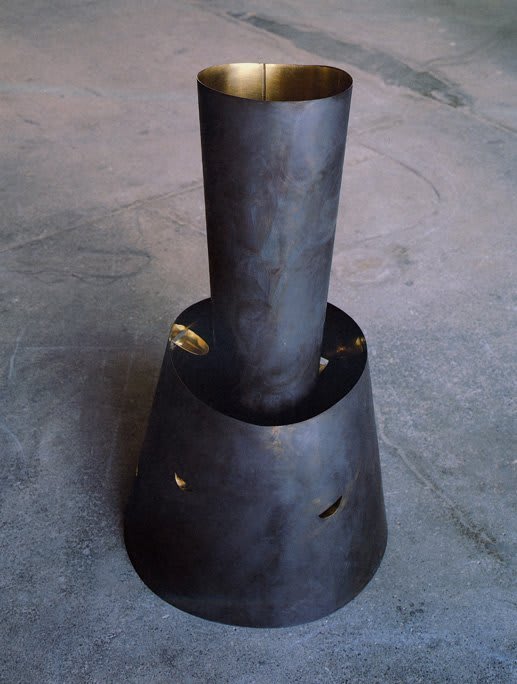Alison Wilding b. 1948
Immersion, 1988
brass
39 1/4 x 19 x 22 inches
99.7 x 48.3 x 55.9 cm
99.7 x 48.3 x 55.9 cm
Archive no.AW 92
‘Some of Alison Wilding's cone or column-like sculptures refer directly to religion in their titles: Vestal for instance. Works such as Immersion, Receiver, Nest, Her Furnace, Vestal, Tidal, Bare, Fugue...
‘Some of Alison Wilding's cone or column-like sculptures refer directly to religion in their titles: Vestal for instance. Works such as Immersion, Receiver, Nest, Her Furnace, Vestal, Tidal, Bare, Fugue and Dismantle all feature cylindrical forms, most of them floor-standing. Some of these forms recall monumental figures, others suggest notions of cradling and protection. Some of the slender standing sculptures have openings at the top, inviting the viewer to peer down into their interiors - Vestal, Immersion, Her Furnace. The act of looking down into the sculpture becomes an important part of consuming the work. The identification with the interior institutes a new sense of self-awareness, a new sense of the body.
One of the most common of Wilding's motifs is one form nestling inside another. Sometimes the two forms fit snugly together, as in Nest, while others such as Immersion and Temper, have more of a gap between the upper narrow form and the lower wider form. Immersion unites two of Wilding's favourite forms, the gently tapering upright cylinder and the shallow cone. The notion of 'immersion' is suggested here in two ways: firstly, as with Nest, the upper form is 'immersed' in the lower form, just as a limb is lowered into water. But, secondly, the notions of inner and outer are emphasised by Wilding's treatment of the surface of this all-brass sculpture. The inner surfaces gleam, as brass gleams around hearths in pre-industrial age houses or in ye-olde pubs. The exterior surface of the brass, the skin of the sculpture, is not polished, but darkened.’ 1
Alison Wilding is one of a group of artists who came to prominence in the early 1980s, known collectively as the New British Sculptors, which also included Tony Cragg, Richard Deacon, Anish Kapoor and Shirazeh Houshiary. Like Deacon, her sculptures are often concerned with the fabrication of forms and the juxtaposition or conjoining of contrasting materials - see for example Assembly 1991, Tate Gallery Collection, a large scale sculpture in which a rhomboid form, made from a grid of transparent plastic strips, is placed side by side with a similar sized tunnel made of sheet steel. Wilding has used a hugely diverse range of materials in her sculptures amongst them steel, brass, lead, stone, textiles, plastic, wax, pigment and ash. She has twice been nominated for the Turner Prize firstly in 1988, the year Immersion was made, and again in 1992. Another work also made of brass, On the Day, 1986, is in the Tate’s permanent collection.
1 Susan Quinnell, Alison Wilding: The Embrace of Sculpture, 2008, pp51-2
One of the most common of Wilding's motifs is one form nestling inside another. Sometimes the two forms fit snugly together, as in Nest, while others such as Immersion and Temper, have more of a gap between the upper narrow form and the lower wider form. Immersion unites two of Wilding's favourite forms, the gently tapering upright cylinder and the shallow cone. The notion of 'immersion' is suggested here in two ways: firstly, as with Nest, the upper form is 'immersed' in the lower form, just as a limb is lowered into water. But, secondly, the notions of inner and outer are emphasised by Wilding's treatment of the surface of this all-brass sculpture. The inner surfaces gleam, as brass gleams around hearths in pre-industrial age houses or in ye-olde pubs. The exterior surface of the brass, the skin of the sculpture, is not polished, but darkened.’ 1
Alison Wilding is one of a group of artists who came to prominence in the early 1980s, known collectively as the New British Sculptors, which also included Tony Cragg, Richard Deacon, Anish Kapoor and Shirazeh Houshiary. Like Deacon, her sculptures are often concerned with the fabrication of forms and the juxtaposition or conjoining of contrasting materials - see for example Assembly 1991, Tate Gallery Collection, a large scale sculpture in which a rhomboid form, made from a grid of transparent plastic strips, is placed side by side with a similar sized tunnel made of sheet steel. Wilding has used a hugely diverse range of materials in her sculptures amongst them steel, brass, lead, stone, textiles, plastic, wax, pigment and ash. She has twice been nominated for the Turner Prize firstly in 1988, the year Immersion was made, and again in 1992. Another work also made of brass, On the Day, 1986, is in the Tate’s permanent collection.
1 Susan Quinnell, Alison Wilding: The Embrace of Sculpture, 2008, pp51-2
Provenance
The Edward R. Broida Trust, USA
Exhibitions
London, Karsten Schubert Gallery, Alison Wilding: Sculptures 1987/8, 10 December 1988 - 28 January 1989, illus b/w p27
Liverpool, Tate Gallery, Alison Wilding, Immersion: Sculpture from Ten Years , 22 May - 4 August 1991, p14, illus b/w, cat no.13, illus colour
Literature
Susan Quinnell, Alison Wilding: The Embrace of Sculpture, Crescent Moon Publishing, 2008, p42, p51-2, p64-5, illus colour as cover image and b/w p94
Join our mailing list
* denotes required fields
We will process the personal data you have supplied to communicate with you in accordance with our Privacy Policy. You can unsubscribe or change your preferences at any time by clicking the link in our emails.
